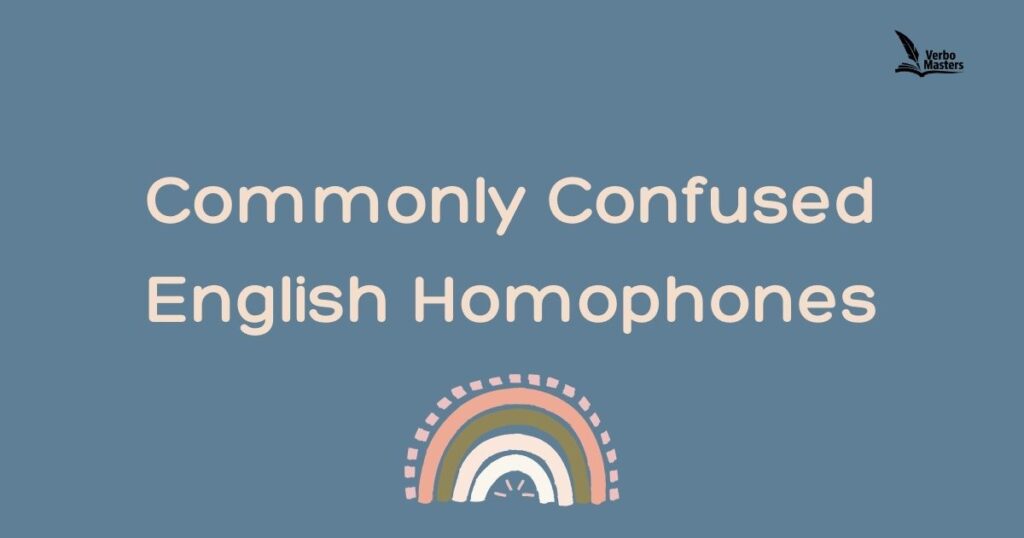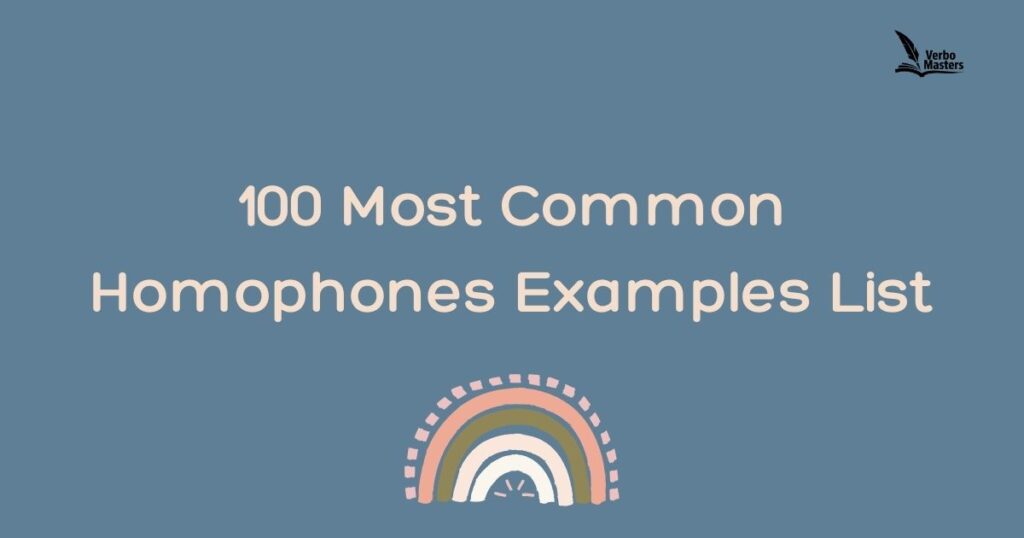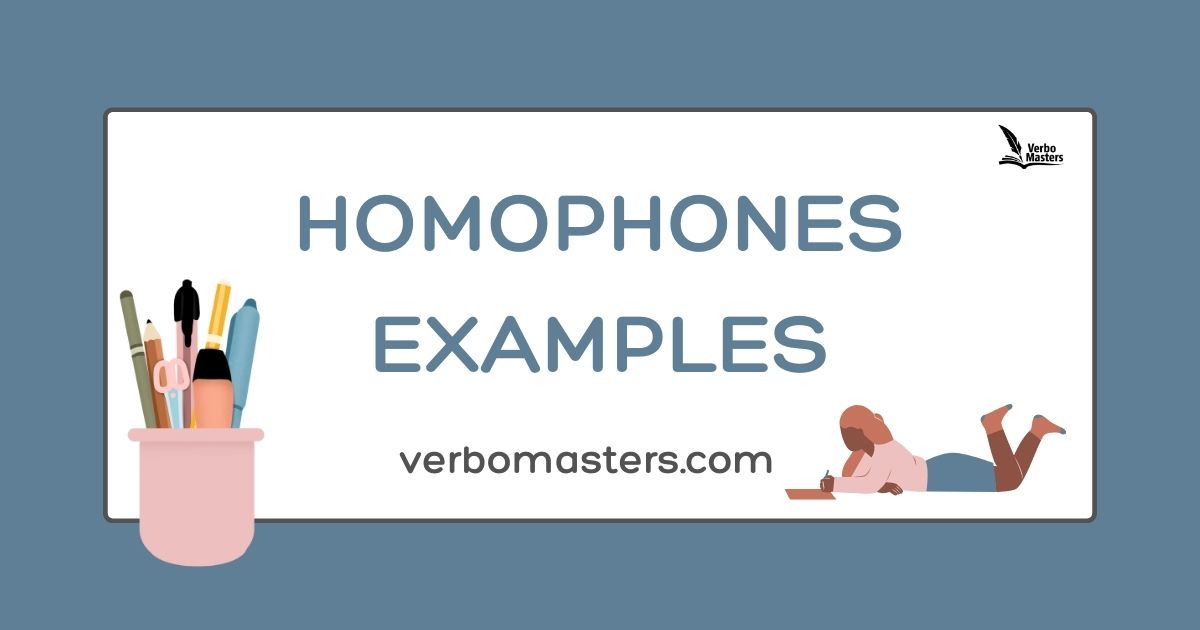Homophones Examples! Homophones are words that sound the same but have different meanings and spellings. They can often cause confusion in writing, but with practice, it’s easy to tell them apart. For example, “bare” and “bear” sound the same, but their meanings are completely different.
Learning homophones can make you a better writer and communicator. They are everywhere in the English language, from simple words like “two,” “to,” and “too” to more complex ones. Let’s look at some examples to see how homophones work in sentences!
What Are Homophones?
Homophones are words that sound the same but have different meanings and spellings. They can be tricky because they sound identical when spoken, but each has a distinct definition and usage in writing. For example, “flower” and “flour” are homophones they sound the same but refer to different things.
In English, homophones are common and understanding them is important to avoid confusion in both writing and speaking. Mastering homophones can improve your language skills and help ensure clarity in communication.
Different Homophone Types in English
simple guide to the different homophone types in English, explained with easy definitions and examples:
1. Homophones
Definition: Words that sound the same but have different meanings and spellings.
📌 Example: “Write” ✍️ and “Right” ✅
2. Homonyms
Definition: Words that sound the same and are spelled the same, but have different meanings.
📌 Example: “Bat” (animal) 🦇 and “Bat” (sports equipment) 🏏
3. Homographs
Definition: Words that are spelled the same but may be pronounced differently and have different meanings.
📌 Example: “Tear” (rip) 💔 vs. “Tear” (from crying) 😢
4. Heteronyms
Definition: A type of homograph—words that are spelled the same but have different pronunciations and meanings.
📌 Example: “Lead” (to guide) 🧭 vs. “Lead” (a metal) 🪙
5. Heterographs
Definition: Words that sound the same but are spelled differently and have different meanings.
📌 Example: “Pair” 👟 and “Pear” 🍐
6. Capitonyms
Definition: Words that change meaning when capitalized; sometimes pronounced the same, sometimes not.
📌 Example: “March” (the month) 📅 vs. “march” (to walk) 🚶♂️
7. Polysemes
Definition: Words with the same spelling and similar but distinct meanings.
📌 Example: “Mouth” (of a river) 🌊 and “Mouth” (part of the face) 👄
8. Oronyms (Phrasal Homophones)
Definition: Phrases that sound like other words or phrases when spoken aloud.
📌 Example: “Ice cream” 🍦 vs. “I scream” 😱
You can also read; 150 Words List of Common Noun VS Proper Nouns
Rules for Using Homophones
simple and helpful rules for using homophones correctly in English:
✅ 1. Understand the Meaning
Before using a homophone, be sure you know its meaning.
📌 Example: “Their” (belongs to them), “There” (a place), “They’re” (they are).
✅ 2. Use Context Clues
Think about the sentence. The meaning of the sentence will help you choose the correct homophone.
📌 Example: I ate eight apples. (“Ate” = action, “Eight” = number)
✅ 3. Spellcheck Isn’t Enough
Spellcheck may not catch homophone mistakes because both words are spelled correctly. Always proofread!
📌 Example: Your vs. You’re
✅ 4. Practice Common Pairs
Familiarize yourself with commonly confused homophones. The more you practice, the easier it becomes.
📌 Example: To, too, two / Hear, here / Right, write
✅ 5. Read Aloud When in Doubt
Reading your sentence aloud can help you catch mistakes, especially when you hear a word that doesn’t make sense in context.
✅ 6. Remember That Homophones Aren’t Interchangeable
Even though they sound the same, each homophone has its own correct usage.
📌 Example: Bare (without covering) ≠ Bear (the animal)
✅ 7. Learn with Examples
Use homophones in sentences when learning to lock their meanings in your memory.
📌 Example: The knight rode through the night.
Commonly Confused English Homophones

commonly confused English homophones that even native speakers mix up explained with short, easy examples:
1. Their / There / They’re
- Their means something belongs to them: That’s their car. 🚗
- There refers to a place: She is over there. 📍
- They’re means they are: They’re going to the movies. 🎬
2. Your / You’re
- Your shows possession: Is this your phone? 📱
- You’re is short for you are: You’re amazing! 🌟
3. To / Too / Two
- To shows direction or purpose: I’m going to the store. 🏬
- Too means also or very: I want to go too! 🙋♀️
- Two is the number 2: I have two cats. 🐱🐱
4. Its / It’s
- Its means something belongs to it: The dog licked its paw. 🐾
- It’s is short for it is: It’s raining outside. ☔
5. Than / Then
- Than is used in comparisons: She is taller than me. 📏
- Then relates to time: We ate, then watched a movie. 🍿
6. Affect / Effect
- Affect is usually a verb: The weather can affect your mood. 🌦
- Effect is usually a noun: That speech had a strong effect. 🎤
7. Brake / Break
- Brake means to stop: Hit the brakes! 🛑
- Break means to separate or damage: Don’t break that vase. 🏺
8. Pair / Pear
- Pair means two of something: A pair of shoes. 👟👟
- Pear is a fruit: I ate a juicy pear. 🍐
9. Principal / Principle
- Principal is a person or main idea: The school principal is nice. 🏫
- Principle is a belief or rule: She has strong principles. 📜
10. Complement / Compliment
- Complement means something that completes: Those colors complement each other. 🎨
- Compliment is a nice remark: He gave me a compliment. 😊
100 Most Common Homophones Examples List

100 most common homophones in English perfect for learning, practice, or improving your grammar! Each pair/trio sounds the same but has different meanings and spellings:
🔤 100 Common Homophones List
- To / Too / Two
- There / Their / They’re
- Your / You’re
- Its / It’s
- Here / Hear
- Right / Write
- Brake / Break
- Buy / By / Bye
- Flower / Flour
- Sea / See
- One / Won
- Bare / Bear
- Son / Sun
- Hour / Our
- Mail / Male
- Pair / Pear
- Know / No
- Peace / Piece
- Plain / Plane
- Whole / Hole
- Be / Bee
- Cell / Sell
- Blue / Blew
- Cent / Scent / Sent
- Allowed / Aloud
- Weak / Week
- Road / Rode
- Steel / Steal
- Heel / Heal
- Knight / Night
- Flew / Flu / Flue
- Eight / Ate
- Rain / Reign / Rein
- Scene / Seen
- Stake / Steak
- Meat / Meet
- Sole / Soul
- Sight / Site / Cite
- Idle / Idol
- Sell / Cell
- Pail / Pale
- Bored / Board
- Lessen / Lesson
- Dye / Die
- Vain / Vein / Vane
- Principal / Principle
- Fair / Fare
- Serial / Cereal
- Capital / Capitol
- Weather / Whether
- Sew / So / Sow
- Tale / Tail
- Waist / Waste
- Hair / Hare
- Grate / Great
- Plane / Plain
- Compliment / Complement
- Dear / Deer
- Moose / Mousse
- Miner / Minor
- Muscle / Mussel
- Right / Rite / Write / Wright
- Toe / Tow
- Knew / New
- Birth / Berth
- Complement / Compliment
- Sail / Sale
- Ladle / Ladel
- Lead / Led
- Bass / Base
- Close / Clothes
- Pause / Paws
- Stationary / Stationery
- Die / Dye
- None / Nun
- Plane / Plain
- Red / Read (past)
- Yolk / Yoke
- Sole / Soul
- Horse / Hoarse
- Altar / Alter
- Root / Route
- Stare / Stair
- Mail / Male
- Ant / Aunt
- Lessen / Lesson
- Oar / Ore / Or
- Passed / Past
- Presence / Presents
- Scent / Cent / Sent
- Profit / Prophet
- Rain / Reign
- Rays / Raise / Raze
- Role / Roll
- Sole / Soul
- Tied / Tide
- Toe / Tow
- Tacks / Tax
- Weak / Week
- Flew / Flu
FAQs
What are homophones?
Homophones are words that sound the same when spoken but have different meanings and spellings. They can often confuse learners and even native speakers.
Why are homophones important to learn?
Homophones are important because using the wrong one can change the meaning of a sentence. They help improve writing, reading, and overall communication skills.
What’s the difference between homophones and homonyms?
Homophones sound the same but are spelled differently. Homonyms can sound the same and be spelled the same but have different meanings depending on the context.
Are there tricks to remember homophones?
Yes, using them in a sentence or creating a fun story can help. Flashcards or visual cues also work well when trying to remember tricky pairs.
Do all homophones have different spellings?
Most do, but not all. Some homophones can be spelled the same but have different meanings, like “bat” (animal) and “bat” (used in sports).
How can I teach kids homophones?
Use simple examples, fun games, matching activities, and picture books. Keeping it visual and playful helps children understand them faster.
Are homophones used in puns or jokes?
Absolutely! Homophones are a great tool for wordplay, puns, and clever jokes because they create double meanings in a sentence.
What are some common homophone mistakes?
Mix-ups like “your” and “you’re,” “their” and “there,” or “to,” “too,” and “two” are some of the most common and often seen in both writing and texting.
Can homophones vary by accent or region?
Yes, some words may be homophones in one accent but not in another. Pronunciation differences can affect whether two words sound the same.
Where can I practice using homophones?
You can use grammar websites, educational apps, worksheets, or even write your own sentences. Reading more helps you naturally spot and learn them, too.
Conclusion
Homophones are fun and tricky words in English. They sound the same but mean very different things. If you mix them up, your sentence can get confusing fast.
Learning homophones helps you write and speak more clearly. It also makes reading easier and more fun. With practice, you’ll get better at spotting the right word.

I’m John Smith, a language enthusiast dedicated to helping writers, students, and professionals master the art of clear and effective communication. Whether you’re looking for grammar tips, writing guides, or common mistake corrections, you’ll find valuable insights to improve your language skills. Let’s make grammar simple and fun!

